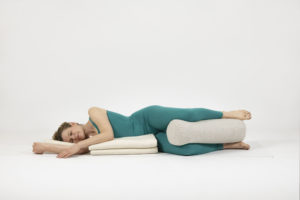
Sunrise over Mount Goken by Fujishima Takeji
by Nina
In my post My Stress and Insomnia are Closely Linked, I mentioned that one of the causes of insomnia can be menopause. And I realized that after I wrote it that we have never had a post on that topic in the whole 10 plus years this blog has been in existence. So I decided it was about time to address this issue and to identify which types of yoga practices might be able to help with menopause-based insomnia.
First of all, I did some quick research to identify what actually causes menopause-based insomnia. I knew that hot flashes did, because that was my own experience. And from what I’ve read, that is the most common cause for women going through hormonal changes. But I actually came up with four different symptoms that can cause insomnia, which related to the hormonal changes we experience during perimenopause and menopause:
- Hot flashes and night sweats
- Restless leg syndrome
- Anxiety and depression
- Sleep apnea
I hope if you’re suffering from menopause-based insomnia, it’s obvious to you what exactly is happening in the middle of the night to disturb your sleep. If not, make it a point to try to figure out what’s going on with your body and mind when you wake up. And if you really can’t figure it out and you really don’t think it is just stress that is disrupting your sleep, you might want to look into the possibility that you have sleep apnea or some other breathing problem during sleep that you’re not aware of.
I’ll address each of these four symptoms individually below. But first I want to say a few words about menopause-based insomnia in general. I think there are some simple strategies that will help all the conditions, at least to some extent.
1. In the moment, accept what is happening. One way to do this is by cultivating the opposite (see Letting Go, Part 1). Come up with a phrase that you can use to tell yourself that menopause is natural and that you’re okay, rather than stressing out about your symptom.
2. Try not to panic about falling back to sleep if you wake in the middle of the night. Instead, do some yoga to calm yourself down, which will make it easier to fall back to sleep. See Better Sleep Tips, Part 3: It’s the Middle of the Night! for ideas. And when you find something that works for you, make it your routine so it’s easy to turn to that practice in the middle of the night.
3. Practice yoga for better sleep as outlined in my series Better Sleep Tips Part 1, Part 2, Part 3, and Part 4. It can be especially helpful to develop a bedtime routine so you have something to do before bed to wind down and also after you get into bed for the night. Having these things to do will help you settle down rather than stressing out ahead of time about how bad your night is going to be.
4. Practice stress management on a regular basis. Lack of sleep can cause you to stress out, which in a vicious circle only makes it even harder to sleep. So keeping your baseline stress levels as low as possible when you have insomnia will at least help eliminate stress from the equation of things that are waking you up. See Stress Management for When You’re Stressed for ideas for practice.
Hot Flashes and Night Sweats
There are many yoga teachers who teach certain yogic practices they say can reduce hot flashes and/or night sweats. See Beth’s post Yoga for Menopause: Managing Hot Flashes for information about breath practices and mudras might help. The book The Woman’s Book of Yoga and Health by Linda Sparrowe has a sequence designed by Patricia Walden and also other information.
(I’ll confess that even though I had hot flashes that woke me up during perimenopause and menopause, I didn’t try practices to reduce them. I just seriously practiced acceptance of them and then was able to go back to sleep quite quickly.)
You can also focus your yoga practice on basic stress management (see Stress Management for When You’re Stressed). Beth says the more stressed you are, the more intense hot flashes are. So it’s worth giving stress management a try to see if that helps. And even if it doesn’t help with the hot flashes, lowering stress levels overall is always good for improving sleep and making your life easier in general so it’s all good.
When wake up in the middle of the night, try:
- Accepting what is happening. When you notice you’re starting to have a hot flash or are sweating, you can use an opposite thought like “I’m okay. These symptoms are natural.” Then either simply observe the hot flash or night sweats without judgment or try a cooling breath.
- Practicing a Cooling Breath. This is a modified version of Sitali Pranayama that Beth recommends in her post Yoga for Menopause: Managing Hot Flashes, where she provides instructions for practicing. She says this breath practice will often stop a hot flash if you can catch it just as it begins. If you can, practice the Cooling Breath regularly so that it is readily available when you feel a hot flash coming on.
- Turning to your falling-asleep-in-the-middle of the night routine. After you cool down one way or another, try any of the practices in Better Sleep Tips, Part 3: It’s the Middle of the Night! that you find helpful. These can help you fall asleep more quickly and sleep more soundly when you do. (And if you like to change your clothes and/or drink some cool water, have those handy by your bed so you don’t have to get up and walk around.)
Restless Leg Syndrome
There is some evidence that stretching your legs and hips can improve restless leg syndrome. So if restless leg syndrome is what is disrupting your sleep, I think it would be a good idea to try some gentle stretches before you go bed and also in the middle of the night when this condition causes you to wake up. I would focus on reclined stretches or seated rather than standing ones because the reclined and seated poses are less stimulating, and you want to keep stimulation to a minimum before bed.
See Baxter’s post about restless leg syndrome Friday Q&A: Restless Leg Syndrome and Featured Sequence: Lower Body Flexibility for ideas for reclined and seated stretches. Interestingly, one of the poses Baxter recommends for restless legs syndrome is Bridge pose, which is also a very calming pose if you do it with support. So if that works for you, that could be doubly helpful.
When wake up in the middle of the night, try:
- Accepting what is happening. When you wake up, try telling yourself that you’re okay and the symptoms are simply caused by menopause. And remind yourself you can try some stretches to see if they help.
- If desired, try some stretches in bed. Probably at this point, reclined stretches will be the most beneficial because even sitting up after lying down is stimulating. If you need a strap for leg stretches, keep one by the bed.
- Turning to your falling-asleep-in-the-middle of the night routine. After your legs have relaxed, try any of the practices in Better Sleep Tips, Part 3: It’s the Middle of the Night! that you find helpful. These can help you fall asleep more quickly and sleep more soundly when you do
Anxiety and Depression
Menopause can bring the onset of anxiety and depression, both of which can disrupt your sleep. If you’re having serious symptoms of either anxiety or depression, it’s a good idea to get some professional help. If your symptoms are milder and/or you’re already getting professional help, you can use yoga to help relieve some of your symptoms and quiet your mind. See Yoga for Anxiety: The Big Picture and Practicing Depression: An Overview and search on those terms for other relevant articles on the blog. You can also find a lot of information on both conditions in my new book Yoga for Times of Change, including several short sequences.
For a falling-asleep-in-the-middle of the night routine, choose something that takes a lot of concentration, such as a breath practice where you extend your exhalation or where you count your exhalations, or a meditation practice with a longer rather than brief mantra. You could also combine your mantra with your breath practice, by inhaling and then reciting your mantra completely on your exhalation. This can help you shift your thoughts away from the anxious or depressed thoughts you’re having—thoughts that can stress you out and keep you awake. See Better Sleep Tips, Part 3: It’s the Middle of the Night! for information about these techniques
When wake up in the middle of the night, try:
- Don’t panic. Remind yourself that you have tools you can use to quiet your mind and replace stressful thoughts based on anxiety or depression with more neutral ones.
- Turning to your falling-asleep-in-the-middle of the night routine. Choose whatever yoga practice takes the most concentration and distracts you from your anxious or depressed thoughts.
Sleep Apnea
This can be a very serious condition, so if you suspect you have it and it is really disrupting your sleep, you should definitely consult a medical professional. From there, basically practicing stress management to help you deal with the stress of having this condition is what might be most beneficial. And if you have to sleep with a CPAP mask, having going-to-bed and middle-of-the-night routines can help with the stress of wearing the mask, which I’m sure must take some getting used to.
If you only have a mild form of sleep apnea, the position you sleep in is something to take into consideration. Sleeping on your back can have a negative effect your breathing, so you should try to train yourself to sleep on your side instead. Make yourself very comfortable by putting a pillow between your legs so your knees don’t press against each other.

When wake up in the middle of the night, try:
- Don’t panic. As quickly as possible, notice what position you’re currently in, and if you’re on your back, turn on to your side and make yourself comfortable there. Then remind yourself you have tools to help you improve your sleep.
- Turning to your falling-asleep-in-the-middle of the night routine. After you’ve change sleep positions, if you don’t quickly fall back to sleep, practice your chosen middle-of-the-night practice from Better Sleep Tips, Part 3: It’s the Middle of the Night!. I would avoid Bridge pose in the night, however, because it might put you to sleep and then you’d soon wake up with another episode of sleep apnea.
• Follow Yoga for Healthy Aging on Facebook and follow Nina on Instagram • Order Yoga for Times of Change here and purchase the companion videos here • Order Yoga for Healthy Aging: A Guide to Lifelong Well-Being here.


Leave A Comment